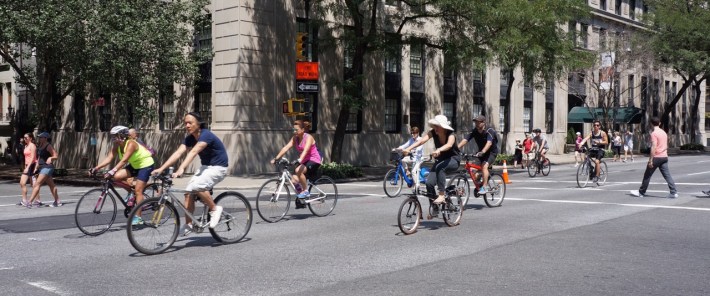
When Summer Streets launched in 2008, it was accompanied by a veritable New York media firestorm. "Will Car-Free 'Summer Streets' Work?" asked the Times. "Businesses Brace for Summer Streets," warned WNYC. Seven years on, New York's marquee car-free event has become a popular August institution. It's time for more.
Since its first edition, Summer Streets has encompassed nearly seven miles of car-free streets on three summer Saturdays, along Park Avenue and Lafayette Street from the Brooklyn Bridge to Central Park. Summer Streets attracted more than 300,000 people last year, DOT said. Yet despite the program's popularity, the city hasn't expanded it.
Smaller "Weekend Walks" events have grown over the years, bringing car-free streets to neighborhoods in all five boroughs. But these pedestrian-focused events aren't the same as Summer Streets, which is big enough to attract people from all over the city. Most important, Summer Streets covers a car-free route long enough to entice New Yorkers onto their bicycles.
There are hurdles to expanding Summer Streets, which already relies on corporate sponsorships. “It takes a lot of funds,” Transportation Commissioner Polly Trottenberg said last year. “We have to work closely with the NYPD. It’s a lot of work to close down the streets, and to their credit, they come to the table and help us with this just out of their own resources.”
If the city can overcome its cost hurdles, there are a few ways to expand Summer Streets. It could be extended to happen on more than just three Saturdays in August, it could last beyond 1 p.m., it could cover a longer route, or it could cover additional routes in boroughs other than Manhattan.
Los Angeles, for example, has expanded its CicLAvia open streets event to downtown Los Angeles, Pasadena, the San Fernando Valley, and Watts, among other neighborhoods, with car-free hours lasting well into the late afternoon.
Where -- and how -- would you expand Summer Streets in New York? Let us know in the comments.





